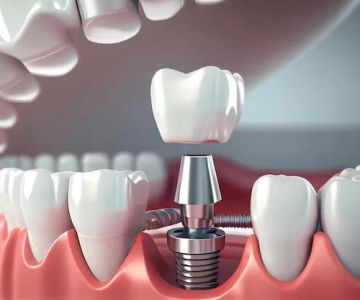Comprehensive Guide to Pulp Restoration: Understanding Treatment and Benefits
- What Is Pulp Restoration?
- Why Pulp Restoration is Important
- Common Pulp Restoration Treatments
- Steps in the Pulp Restoration Process
- Aftercare and Recovery
- Final Thoughts and Purchase Guide
What Is Pulp Restoration?
Pulp restoration refers to the therapeutic procedures used to save and repair the soft tissue (dental pulp) inside your teeth when it's damaged or infected. The dental pulp contains nerves, blood vessels, and connective tissue. When the pulp becomes infected due to trauma or deep decay, pulp restoration procedures become necessary to prevent further complications, such as abscesses or tooth loss.
Why Pulp Restoration is Important
Dental pulp plays a crucial role in maintaining the health of your tooth. If it becomes infected or damaged, the entire tooth may weaken, leading to severe pain or tooth loss. Without pulp restoration, untreated issues can spread to other areas of the mouth, causing systemic infections. In essence, pulp restoration aims to save your natural tooth while preserving its function and structure.
For example, a patient might experience persistent tooth pain caused by an infected pulp. Without intervention, the infection could spread, requiring tooth extraction. However, with proper pulp restoration treatments like root canal therapy, the tooth can be preserved, saving the patient from more invasive procedures.
Common Pulp Restoration Treatments
There are several treatment options for pulp restoration, and the choice of treatment depends on the severity of the pulp damage. The most common treatments include:
- Root Canal Therapy (RCT): The most common pulp restoration treatment, RCT involves removing the infected pulp, cleaning the inside of the tooth, and sealing it to prevent further infection.
- Pulp Capping: In cases of minor pulp inflammation, a protective material may be placed on the exposed pulp to promote healing.
- Pulpotomy: Typically performed on primary (baby) teeth, this involves removing the infected portion of the pulp and preserving the healthy part to avoid tooth extraction.
Steps in the Pulp Restoration Process
The pulp restoration process generally follows these steps:
- Initial Assessment: The dentist will assess the tooth's condition, often using X-rays to determine the extent of the pulp damage.
- Anesthesia: Local anesthesia is applied to ensure the patient is comfortable throughout the procedure.
- Pulp Removal: For root canal therapy, the dentist removes the damaged pulp from inside the tooth.
- Cleaning and Disinfection: The inside of the tooth is cleaned and disinfected to eliminate any remaining bacteria or infection.
- Sealing the Tooth: The tooth is sealed with a filling or crown to prevent future infection.
Each step is critical to ensure the success of the restoration and the long-term health of the tooth.
Aftercare and Recovery
After pulp restoration treatments like root canals or pulp capping, proper aftercare is essential for a smooth recovery. Patients may experience mild discomfort for a few days, but this can be managed with over-the-counter pain medications. It's important to avoid chewing on the treated tooth until it is fully healed to prevent any damage. Regular follow-up appointments with your dentist will ensure that the restoration is successful and the tooth remains healthy.
For example, following a root canal treatment, it's common for patients to wear a temporary crown until the permanent one can be placed. Regular brushing, flossing, and avoiding hard foods will also speed up the healing process.
Final Thoughts and Purchase Guide
Pulp restoration is a vital aspect of modern dentistry that helps preserve your natural teeth. Whether you're dealing with a root canal or need minor pulp therapy, these treatments can significantly improve your oral health and save you from more invasive procedures. If you're considering pulp restoration, it’s important to consult with a qualified dentist to determine the best course of action for your specific needs.
At Dentistry Toothtruth, we offer comprehensive information on dental treatments, including pulp restoration. Visit our site for more details on how we can help you maintain a healthy, beautiful smile.







 Corona Family Dental Group3.0 (42 review)
Corona Family Dental Group3.0 (42 review) Genesis Dental of Taylorsville4.0 (842 review)
Genesis Dental of Taylorsville4.0 (842 review) Edmond Dental Center: Michael Chandler, DDS5.0 (404 review)
Edmond Dental Center: Michael Chandler, DDS5.0 (404 review) Cash Family Orthodontics4.0 (141 review)
Cash Family Orthodontics4.0 (141 review) Spring View Dental Care4.0 (1298 review)
Spring View Dental Care4.0 (1298 review) Acworth Smiles Dentistry4.0 (145 review)
Acworth Smiles Dentistry4.0 (145 review) The Importance of Oral Health Education During Pregnancy for a Healthy Pregnancy
The Importance of Oral Health Education During Pregnancy for a Healthy Pregnancy Best Tips for Brushing Your Teeth Properly for Healthy Gums: Essential Techniques for Oral Health
Best Tips for Brushing Your Teeth Properly for Healthy Gums: Essential Techniques for Oral Health Why Skipping Dental Checkups Can Lead to Bigger Oral Health Problems
Why Skipping Dental Checkups Can Lead to Bigger Oral Health Problems Advantages of Porcelain Dental Restorations
Advantages of Porcelain Dental Restorations How Can Diabetes Cause Tooth and Gum Problems? Preventing and Managing Oral Health Issues
How Can Diabetes Cause Tooth and Gum Problems? Preventing and Managing Oral Health Issues Healthy Habits for Promoting Good Oral Health and Hygiene: Tips for a Healthy Smile
Healthy Habits for Promoting Good Oral Health and Hygiene: Tips for a Healthy Smile